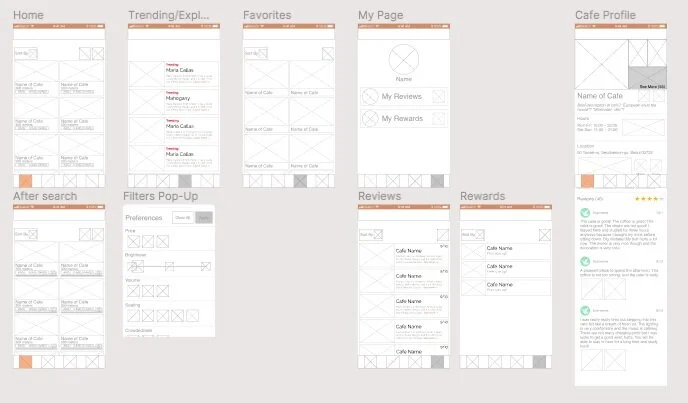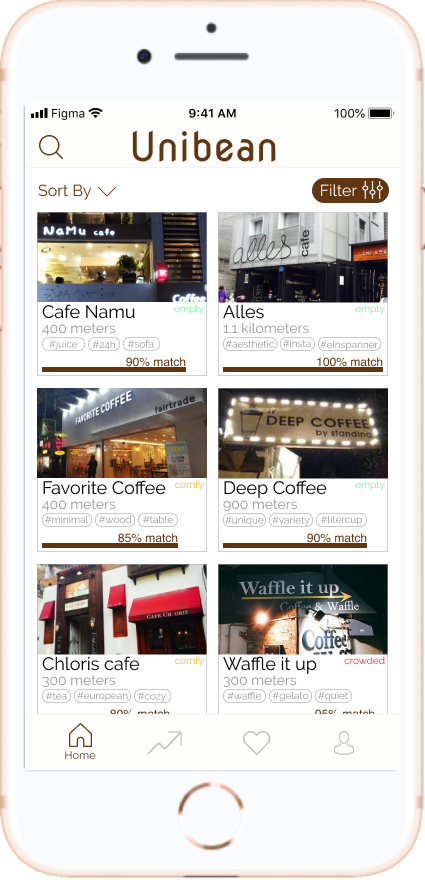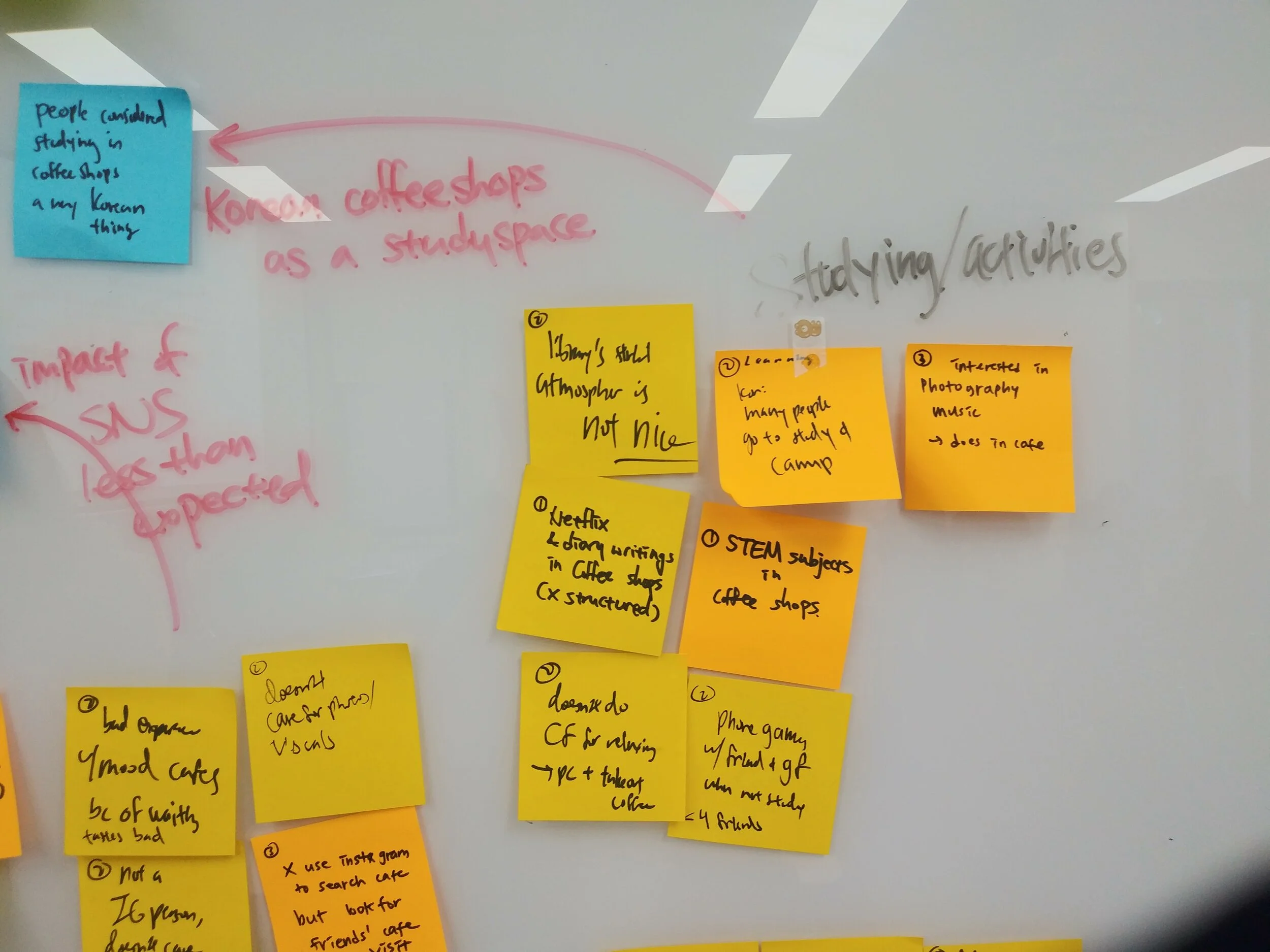Unibean — Overview
An immersive study-abroad experience exploring South Korea’s unique coffee culture and designing a digital service within it.
Background and Goals
In my term abroad in Seoul, South Korea, I took Culture and Service Design at Yonsei University. Each team thoroughly conducted and synthesized research on one aspect of Korean culture, and then designed a service to address a pain point. My team was tasked with exploring Korean coffee culture.
Product
UniBean is a mobile app service designed exclusively for university students in Seoul, South Korea.
Addresses the common problem of navigating many crowded cafes before settling down.
Recommends cafes based on individual preferences optimized for college student needs.
Service partnership with family-owned coffee shops funnels students towards local small businesses.
Skills
User research • Contextual inquiry • Service design • UI/UX design for mobile • Localized/international design
Time Frame
12 weeks
Team
Sueyeon Chae, Changhyun Kim, Jiyoon Roh, Cindy Yuan
My Responsibilities
Leading user research and synthesis, designing app from wireframe to high-fidelity prototype
User Research
How do Korean university students experience coffee culture?
We first conducted existing literature research of Korean coffee culture and the coffee industry. As we went about our daily lives, we also did informal observational studies on cafes around Yonsei. I closely observed some characteristics of Korean coffee shops that were different from in the US.
From this preliminary research, we found that…
For Koreans, coffee isn’t a morning drink. Coffee shops opened late at 10AM, and closed late at 11PM-1AM.
While the Korean coffee industry is booming, individually-owned shops are struggling as large chains take over market share.
Compared to the average price of food and drink, a cup of coffee is incredibly expensive. Most consumers perceive coffee as expensive — one drink can cost as much as a meal.
With these findings in mind, we hypothesized that…
Coffee shops in Korea are not about coffee.
Contextual User Interviews
Based on this hypothesis, we chose to interview Korean college students between ages 19-24 through contextual user interviews. These interviews were roughly 90 minutes in length with a balance of general daily life questions, and four focus areas: Coffee, Events and Purpose, Space and Environment, and Socializing.
We asked our interviewees to choose their favorite coffee shop within a 2 kilometer radius of campus in order to bring to mind their recent memories. We also observed how they moved through drink selection, seat selection, and interacted with the space post-interview.
Devising the Two Column Interview Guide
I led the creation of our interview guide, which follows a two column format.
Addressing team communication issues
I came up with this format after noticing that our team had very different interpretations of questions, and things kept getting lost in translation.
My teammates were interviewing in Korean and I was interviewing in English, so it was crucial that we had the same understanding of each question.
Using hierarchy for clarity and agility
Questions and additional probes are grouped on the left. The right column contains corresponding reasoning produced through team discussion and review. Each focus area is distinctly grouped to create a natural progression.
This flexible structure is easy to memorize and refer to, allowing interviewers to make quick adjustments throughout the interview.
Key Insights
Our most crucial findings that revealed an opportunity to improve.
From our user interviews, we mapped our observations through clustering by similarity, then applied the “5 Whys” to derive some exciting insights:
Insight: Coffee shops are a modernized form of Korean post-meal traditions.
Our interviewees went to coffee shops after meals, which lined up with Naver’s peak hours at popular cafes.
Something “extra” was needed to complete a meal, and interviewees varied their drinks based on the type of food they ate. We found precedent for this something extra in Korean traditions such as Sikhye or Soongnyung.
Coffee shops serve as ideal venues to continue ongoing conversations with friends: a heavy menu emphasis on desserts with light drinks that complemented rich, spicy Korean cuisine.
“Usually I go to coffee shops at around 7pm, after school and after dinner.”
“Black coffee takes out that oily feeling of lunch.”
“If I had heavy food, I have a light Americano. If I had light food, then I have a vanilla latte.”
Insight: Coffee shops are flexible study and social spaces that appeal to a variety of individual preferences.
None of our interviewees cited to-go coffee as a reason to visit a cafe — visiting a cafe without spending at least 1 hour there was a waste of money. Buying a drink at a coffee shop was to pay for the space.
Coffee Shops As Study Spaces
For college students, coffee shops served as a happy medium between two extreme study spaces. The range of coffee shops means that they offer a variety of seats, surfaces, and ambiance.
While one’s home environment and the library environment are static and rarely change, there are so many coffee shops that individuals can move around as their tastes change.
Coffee Shops As Social Spaces
Students also visited cafes to socialize with friends or go on dates.
Compared to the alternatives for affordable social spaces, for the cost-conscious university student who just wants to hang out, coffee shops came out on top.
Insight: Students settle for uncomfortable spots at a handful of cafes during peak hours.
Each of our interviewees had particular preferences when it came to seat type, lighting, and surfaces, which also varied depending on the activity.
Through their stories, we noticed frustration about being able to find the perfect spots for either studying or socializing at peak hours — they often settled for uncomfortable seats.
The area around Yonsei University has a smattering of cafes, but most of our interviewees had a go-to list of favorites, rarely exploring.
From our insights, we asked ourselves,
How might we help frustrated college students efficiently find compatible coffee shops?
We created a persona to help us evaluate this question:
Our Service Design Solution
Introducing Unibean: connecting university students with local small businesses through coffee.
Unibean Service Concept
The user-facing mobile app presents a student-centered way to search for coffee shops based on price, distance, crowdedness, ambiance, and studying necessities.
Unibean partners exclusively with individual coffee shops to redirect students towards unknown local businesses. This partnership allows us to offer student rewards, ambiance information, and “studying necessities” information on the mobile app.
Check out our concept video!
Edited by: Changhyun Kim
Localized Design
As the only member of our team with prior experience designing mobile apps, I was responsible for the UI/UX design of Unibean from wireframing to high-fidelity prototyping, based on team-generated design values, style guide, and features.
Since this app is meant to be for Korean university students, I put text elements closer together than I normally would. Korean characters are shorter and square, and our competitive UX analysis showed that similar services, such as the Korean app MangoPlate, used tighter spacing.
Product Core Features
Customized Matching
Students can input their preferences and receive results based on match. We chose price, brightness, volume, wifi, charging outlets, and desk-style tables based on our analysis of what students valued in cafes.
When socializing, a student may want higher volume cafes that are dimmer. When studying, the same student may want lower volume cafes that are brighter with desk-style tables.
Hashtags
Hashtags are trendy in Korean mobile apps, and are widely used in the Instagram culture of university students. We incorporated hashtags to give users an idea of a cafe’s speciality or ambiance at a glance.
Click through our live prototype!
Reflection
Looking back at conducting in-depth research and designing for a non-American community.
Next Steps
As our class was user research focused, our projects ended at conceptualization and, in our case, one iteration of our mobile application. Naturally, testing our service with local coffee shop owners as well as the mobile application and branding with university students are the next steps to take. We also did not learn any specific service design methods, so I would like to redesign our model through more specialized techniques such as service blueprints. Looking back, I also believe that our small font and color choices of light text makes our app inaccessible to individuals who are visually impaired. I would like to revise our style guide to fit accessibility standards.
My Takeaways
This project was an interesting change of pace and my first exposure to service design and overseas design thinking. Some main challenges were:
Researching the area without solutions in mind — User research was the focus for over half of this course. We had to approach our research and learnings with extremely open mindsets, refraining from allowing potential solution ideas to influence our process.
Cultural team differences and localized design — As the only exchange student in the class, my approach to design was wildly different from that of my teammates. Over the course of the term, we adjusted to these differences to make the best of both worlds, arriving at unique mashup between the design approaches of our respective schools.
Creating something new in an established, highly designed industry — The Korean coffee industry is already established, thoroughly designed, and is globally notorious — we grappled with how to improve it and had to dig deeper to address their fundamental needs.
The pace of the course greatly enhanced my user research skills, as we were given a lot of time to tweak our questions and extract insights. It was extremely satisfying to conduct lengthy, ethnographic interviews and discover surprising insights about coffee — something so routine and surface-level for the average consumer.
I also saw how some of my own design styles and values were influenced by American culture and Dartmouth’s design thinking style. Physically working alongside Korean teammates allowed me to truly experience both localized and universal design. In the future, I want to further understand designing for local and international audiences, especially the role of user research in relation to a designer’s own cultural influences.
















